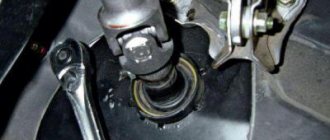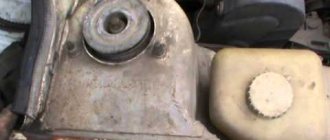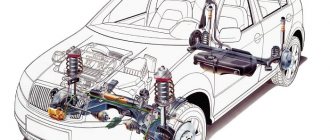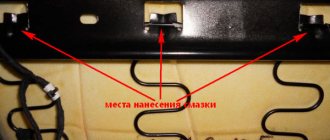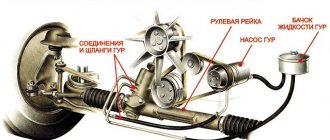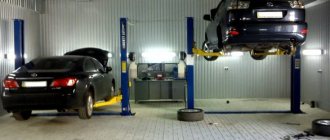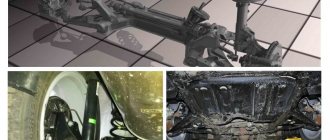This article discusses the main reasons why clicks are heard when turning the steering wheel. Describes how to diagnose and solve this problem.
Author: Raul_ HF and wheel alignment mechanic; experience – 3 years. Service/repair consultant at Toyota DC; experience – 4 years.
Normal operation of the steering system should not be accompanied by extraneous sounds, such as knocking or clicking noises when turning the steering wheel. The appearance of such symptoms indicates the likelihood of wear of components of one of the most important active safety systems of the car, or other components of the chassis that are driven along with the rotation of the steering wheel.
Possible causes of extraneous sounds when turning the steering wheel:
- wear of the steering rack drive shaft cardan crosspieces
- play in the splined connection of the rack drive shaft
- wear of the steering rack supports
- biting the steering rack rod
- radial play of the steering column shaft
- moisture ingress and corrosion of the lower ball joint
- wheel drive grenade malfunction
- violation of the integrity of the spring
Wear of crosspieces of cardan joints of rack drive shaft
If you hear clicks when turning the steering wheel, which can also be felt on the steering wheel, you should check the condition of the steering drive elements. The wear of the crosspieces is detected by probing the universal joint when turning the steering wheel to the right and left at a small angle.
The bite is clearly felt by the hand and allows you to accurately identify the worn part. It is necessary to take into account that there are several such parts and some may be located in hard-to-reach places. In some cases, it may be necessary to dismantle components to disassemble and inspect components, followed by replacement of the faulty part.
Noises from power steering
Despite the fact that electric power steering is being introduced very often today, the main driver assistant when steering in most passenger cars remains power steering. This unit may make noise due to a lack of working fluid. In this case, you need to add it to a tank specially designed for this purpose. Just add the same liquid that the manufacturer used, the amplifier itself is configured specifically for the operating parameters of a particular product, and the use of a different liquid can be very negatively perceived by the amplifier. In addition to the lack of working fluid, the cause of noise in the power steering can be its pump, if it is about to die, you also need to check the condition of the power steering belt, because certain difficulties can also arise with it. And if the condition of the power steering belt makes you suspicious, it is better to replace the belt.
Play in spline joints
Play in the splined connections of the rack drive shaft is detected in a similar way. In some cases, the so-called “bleeding” of the shaft can help. To do this, you need to loosen the fastening bolt and move the shaft several times along the splines, then tighten it again. There is a possibility that the splines, as a result of wear, have lost effective engagement and, as a result of such a procedure, will come into more intimate contact, and the free play in the connection will be eliminated for some period of time. If bleeding does not help, change the spline shaft.
Knock on the front left side (beating in the steering wheel)
Hello!
Digression: don’t kick me too hard, I’m not a lawyer or a car mechanic.
Prehistory: As I wrote earlier about knocking. In April, I visited one of the officials because when driving through transverse cracks in the road surface, I heard a knocking sound on the left side (front). 2 Of. dealer in the city. We drove with the receptionist along public roads and came back. Next is the master receiver and me. MP - nothing was discovered during the trip, everything is fine with you. I - somehow, I feel that it’s not. MP, they say, if you want, let’s put it on the lift, Ok. They drove it in, looked at it, and said that everything was fine and you were charged 1300. Since nothing was found, the owner pays for the diagnostics. Fine. I drove and drove, and in the end I began to get tired of this knocking. In November I went to the second official dealer. He complained, like this and that, he was tired, the knocking turns into rattling. To which the warranty master, hereinafter referred to as MG, said they went there on a “special route” to identify all the faults. We went for a ride, I drove, he was a passenger. We came back. MG - everything is great with you, I didn’t feel anything (speed on a special highway 10-max up to 30 km/h) and there are not even any creaks of the stabilizer bushings. How can I say that, because I’m squeezing that rumble with my butt? MG - on the lift, I - yes! After about an hour, pick up the car and you will pay 1135 rubles. What am I for? Nothing has been revealed and they say you pay. Paid and left. Since it’s normal for AvtoVAZ that
and. And over time, this knocking got to me, + on top of that, the beating in the steering wheel intensified. I gave up on everything and went to the Rising Sun dealer. Where I was warned. that since the car is under warranty, there will be mainly a visual inspection, without analysis, and that the possibility of identifying a defect will be 50/50. I understand and agree, go for it. When I was there, they first lifted the car, checked it by hand and found a knock in the steering rack. Which was detected during transverse rolling of the wheel. The master and I sat down and went for a ride, when he heard a “knock” he ohu@l, thereby cementing his verdict. Confirming this with a piece of paper. I paid 780 rubles and the car wash was free. :-) By the way, when you go to AvtoVAZ officials about the service, you understand that they somehow care about you. The main thing is money, but even here for the money we pay, there is no service. By the way, in general. And if you are under warranty, then... I liked everything about the “Rising Sun” dealer, including the way they greeted me, walked me through, showed me, and explained everything in simple terms. although I am not their buyer. Well, this is so, not an advertisement, but a memory that during this time was positive. And so in December I go again to the first official for diagnostics. From the offer to go for a ride with the master receptionist, I answer that they have already gone. Drive onto the “overpass”! And oh MIRACLE!!! Two points have been identified. Steering rack - knocking and the fact that the stabilizer bushings are even less so, but you can change them under warranty. I was happy, but as always we live in Russia! I don't want to offend anyone under any circumstances. I love my country! And I haven’t been to other countries. For a spoonful of honey there is a barrel of ointment. The warranty engineer who orders the parts is on vacation and there is no replacement for him. Wait until the end of the New Year holidays. But you can contact the second off-dealer, maybe they have something. Here my soul was inspired again. after all, the official gave me a paper where it was written in black and white. But no matter how high I flew in my dreams, when I arrived at the 2nd dealer, the wings were clipped to the ground. The statement that this paper is from an official means nothing to them. And they require diagnostics at their service center, with an offer to do a test drive in the presence of a warranty engineer. Nervous laughter, with a struggling desire to tell them to fuck off! As a result, the car was raised and the engineer confirmed the knock. An unsubscribe was made to the manufacturer. Response received: Make a video. The video was filmed and sent. Calling back the next day, I was invited to the service. since the response from the manufacturer was as follows: make a video with the localization of sounds (malfunction). They took it off and sent it. I went home again. Since the video was sent during the day, and with the manufacturer the time is 1 hour ahead in Izhevsk. They call, they say come, but the plant does not give the go-ahead to replace the steering wheel. since the car has low mileage and no such requests have been recorded. Here I came. That is, it turns out that since there were no appeals, then this cannot happen. Find a specific defect and localize it using video.
And over time, this knocking got to me, + on top of that, the beating in the steering wheel intensified. I gave up on everything and went to the Rising Sun dealer. Where I was warned. that since the car is under warranty, there will be mainly a visual inspection, without analysis, and that the possibility of identifying a defect will be 50/50. I understand and agree, go for it. When I was there, they first lifted the car, checked it by hand and found a knock in the steering rack. Which was detected during transverse rolling of the wheel. The master and I sat down and went for a ride, when he heard a “knock” he ohu@l, thereby cementing his verdict. Confirming this with a piece of paper. I paid 780 rubles and the car wash was free. :-) By the way, when you go to AvtoVAZ officials about the service, you understand that they somehow care about you. The main thing is money, but even here for the money we pay, there is no service. By the way, in general. And if you are under warranty, then... I liked everything about the “Rising Sun” dealer, including the way they greeted me, walked me through, showed me, and explained everything in simple terms. although I am not their buyer. Well, this is so, not an advertisement, but a memory that during this time was positive. And so in December I go again to the first official for diagnostics. From the offer to go for a ride with the master receptionist, I answer that they have already gone. Drive onto the “overpass”! And oh MIRACLE!!! Two points have been identified. Steering rack - knocking and the fact that the stabilizer bushings are even less so, but you can change them under warranty. I was happy, but as always we live in Russia! I don't want to offend anyone under any circumstances. I love my country! And I haven’t been to other countries. For a spoonful of honey there is a barrel of ointment. The warranty engineer who orders the parts is on vacation and there is no replacement for him. Wait until the end of the New Year holidays. But you can contact the second off-dealer, maybe they have something. Here my soul was inspired again. after all, the official gave me a paper where it was written in black and white. But no matter how high I flew in my dreams, when I arrived at the 2nd dealer, the wings were clipped to the ground. The statement that this paper is from an official means nothing to them. And they require diagnostics at their service center, with an offer to do a test drive in the presence of a warranty engineer. Nervous laughter, with a struggling desire to tell them to fuck off! As a result, the car was raised and the engineer confirmed the knock. An unsubscribe was made to the manufacturer. Response received: Make a video. The video was filmed and sent. Calling back the next day, I was invited to the service. since the response from the manufacturer was as follows: make a video with the localization of sounds (malfunction). They took it off and sent it. I went home again. Since the video was sent during the day, and with the manufacturer the time is 1 hour ahead in Izhevsk. They call, they say come, but the plant does not give the go-ahead to replace the steering wheel. since the car has low mileage and no such requests have been recorded. Here I came. That is, it turns out that since there were no appeals, then this cannot happen. Find a specific defect and localize it using video.
RESULT: having arrived at the service today by 09:30, I left at 18:00 with nothing. I asked for an act. They refused, saying that the problem had not been solved and the specific defect had not been identified, and since it was not identified, then there was no paper! They offered to leave the car at the service station, for how long it is not known. In a conversation with Eng. under warranty the question was asked: why leave?, to which I received an answer for identification. FUCK!!!!! And all these days were not enough, crawling almost near one unit (steering river - steering mechanism) to find out what exactly it is??? IG, well... we need to find out specifically. I took the car. So far there are only two ways: 1. Wait for a warranty engineer in another salon and find out the verdict. If (+), then I will be glad. If (-), then there is an independent examination.
By car: I like the car! The attitude of the manufacturer is infuriating: you bought it and go to hell, but we got 50,000 Vesta off the assembly line! I have modified the hard floor in the trunk, if anyone is interested, I will answer. Now it’s definitely rigid, and you can safely put something heavy without fear that the pressed cardboard will be crushed. That's all. Later I’ll write about contacting the official whose IG is coming back from vacation and what will come of it. Thank you for reading. I will be glad for practical advice. It just hurt a lot and I wanted to speak out. Thanks again! I have attached photos of the outfits I ordered.
Worn steering rack supports
During the operation of the car, not only the steering rack mechanism, which takes up the load with each turn of the wheels, wears out, but also the rubber fasteners, through which the unit is fixed to the body or subframe, are subject to wear, destruction and loss of elastic properties. In this case, when you turn the steering wheel in place, you will feel characteristic knocks or clicks, indicating that the rack body is moving freely. The larger it is, the stronger the sound will be under load. Wear is detected by monitoring the position of the unit when the steering wheel is turned left and right. At the same time, the movement of her body will be clearly noticeable. The solution is to either seal the clamps by placing a layer of rubber under them, or immediately replace worn-out rubber bands with new ones.
Causes of knocking noise when turning the steering wheel
There are a number of reasons why a knock is heard when turning the steering wheel. To more accurately determine the malfunction, it is necessary to determine three circumstances:
- Sound type. It can be single or repeated, voiceless or voiced (usually metallic), loud or quiet.
- The place from which the sound comes. For example, in the wheel, in the suspension, in the steering wheel.
- Circumstances of occurrence. In particular, when driving, when turning the steering wheel in place, when the steering wheel is turned all the way, when turning left or right.
Based on such data, you can focus on the source of the knocking sound.
| Place of knock | Causes of knocking |
| Knocking in the wheel | Partial failure of the angular velocity joint (the boot is torn, problems with the bearing), noise from tie rods/steering rods, steering rack when driving on rough roads, shock absorber struts (spring knocking), stabilizer struts |
| Rack knock | Damage to the rack shaft, increased play of the bushing and/or shaft bearings, on machines with electric power steering, mechanical damage to the engine shaft and/or worm drive, wear in the steering shaft driveshaft |
| Knocking in the steering wheel | Partial failure of the steering rack, rusting of the rack drive shaft, wear of the worm drive in the EUR and/or mechanical problems with the electric motor |
| Steering wheel position | Causes of knocking |
| When turning the steering wheel all the way (left/right) | When replacing the front control arm, it is possible that the lever hits the subframe when turning. Sometimes craftsmen simply do not fully tighten the fasteners, which cause them to creak when turning. |
| When turning the steering wheel while the car is stationary | Faulty steering rack, universal joint, loose fasteners, tie rods/ends |
| When turning the steering wheel while the car is moving | The same reasons as when the car is stationary, but problems with stabilizer struts and shock absorber struts are added here. |
Below is a list of reasons why knocking occurs when turning in the area of the wheel, suspension and steering wheel, according to the degree of their prevalence.
Biting the steering rack rod
Biting the steering wheel when rotating indicates damage to the rod due to corrosion as a result of moisture getting inside the body. Typically, biting appears when the steering wheel is turned to a certain angle or number of revolutions. When a rusty section of the rod passes through the plastic guide bushing, strong friction occurs, since the surface of the rod is no longer mirror-smooth, but rough. This is accompanied by a characteristic creaking or clicking sound when turning the steering wheel. The unit must be disassembled and inspected for parts damaged by corrosion, followed by their replacement. In advanced cases, the entire rack will need to be replaced.
Broken strut spring
Often the cause of extraneous sounds is a spring that has burst as a result of metal fatigue. A failed spring can be easily identified by inspection. The elastic suspension element should be replaced in pairs with the opposite one to avoid body distortion. A broken coil can touch the body or other parts, producing grinding and clicking noises when turning the steering wheel.
Good day to all. The problem is that when turning the steering wheel there are loud clicks in the area of the right wheel. I have had pumps, ends, ball bearings and bearings changed in 4 services. The result is zero. The masters just shrug their shoulders, saying that this is the first time we’ve seen this and what the reason is, no one can say; we’ve already spent a fair amount of money, but the problem remains. Has anyone had a similar case?
I've already replaced 2 pieces in a month.
by Adminrive · Published 03/06/2015
In the region of 1900-2200 rpm there is a dip
by Adminrive · Published 04/11/2015
Steering column shaft play
Clicks in the steering column usually appear while the car is moving and indicate the presence of radial play in the shaft as a result of bearing wear. Backlash is diagnosed simply - just reach the shaft with your hand and try to swing it relative to the axis of rotation. If a malfunction is confirmed, repair of the steering column is possible on some cars; on other models, only replacement of the entire assembly is possible.
The malfunction is not critical and, apart from an unpleasant knock, will not cause any other consequences for some time.
Constant-velocity joint
With the wheels turned completely to one side, the CV joint will most often creak (it may even give impacts to the steering wheel). When turning the car to the left, the right outer CV joint will crunch/knock, and when turning to the right, the left one will, accordingly. Inner CV joints usually creak when driving at high speed on uneven roads, so they have nothing to do with knocking when turning. So if you hear a knocking sound when turning or sharply accelerating your car, the outer joint most likely needs to be replaced. However, first you can remove it and inspect it - if there is no wear or it is small, then CV joint lubrication will help.
Corrosion damage to the lower ball joint
A rusty lower ball joint, which bears a significant load, can produce characteristic clicks and a fairly loud squeak when turning. The reason is mechanical damage to the boot and moisture ingress, which leads to leaching of the lubricant. In addition to the creaking, there is usually already some play in the connection, formed as a result of friction of the rusty ball against the plastic seal. As a result of the play, a clearly audible knocking sound occurs when driving over uneven surfaces. A ball joint damaged by corrosion must be replaced.
Causes of clicking noises when turning the steering wheel
If the steering wheel clicks when turning, and this sound is heard with every maneuver performed, then first you need to determine the nature of the sound. If the sound is clear and ringing, then this indicates the presence of a metal-to-metal impact. If the sound is less clear, muffled, then this is more likely a contact of metal and plastic. In addition, it is necessary to determine at least the approximate location where the sound comes from. This will not only reduce the troubleshooting area, but will also help to at least approximately determine the breakdown.
Additional symptoms
Causes of clicks in the steering column
As we see, there can be many reasons for clicks in the steering wheel. Suspicious symptoms may include the hum of wheels, tapping, ringing, crackling, etc. In addition, it is always necessary to monitor the behavior of the car itself. If there is one breakdown or another, the car will not behave as usual on the road. If the tip or bushing breaks, the car may “wobble” while driving. If the CV joint is faulty, the clicking will increase over time to an unpleasant grinding sound. The car will always show what is wrong with it.
Eats rubber from the inside on VAZ-2101-07 cars
On any car, the tread on those wheels that are driving wears out first, so on all rear-wheel drive VAZs, the tires on the rear axle are eaten up more intensively. The main reasons for the intensive wear of tires on the “Classic”:
- the geometry of the body is broken (usually after a blow to the rear);
- bent “stocking” (housing) of the rear axle;
- jet rods are faulty (bent, bushings are broken);
- crooked rims;
- Wheel alignment is not adjusted.
Uneven wear of the tread of one of the tires on an axle can occur due to different pressures in the tires, for example, in one wheel there is 1.5 Atm, in the other - 2 Atm.
The cause of tire burn on the front axle of a VAZ is often faulty silent blocks; here the internal bushings can become dislodged or broken. Also, rubber often wears out due to an impact on the wheel (falling into a hole at speed), in which case the tire on the side of the axle where the damage occurred is “eaten” more intensely.
The same problems with tread wear are observed on Niva cars, since the suspension of this model is structurally almost the same as on the VAZ-Classic.
Why does it eat the tire from the outside front or rear?
More often the cause of such a defect is a broken camber. If its angle is too positive, excessive abrasion of the outer shoulders of the rubber is observed. The final conclusion is made only after examining the suspension parts, the essence of which we outlined in the previous section.
If the wheel alignment is set, the suspension is “normal”, but the rubber is still eating from the outer edge, then the problem is with the tires. There are plenty of examples of when it is enough to replace a set of tires with a new one, and problems with tread development at the rear and front immediately disappear.
For example, the Kama Euro 129 is distinguished by its fat on the outside: after 1,000-2,000 km, uneven tire geometry is observed. And this is another nail in the list of their shortcomings, although they are already not the most wear-resistant summer tires with a strong sidewall among the participants in the fresh test.
How to check the oil level in a cable transmission on a Liftback?
Dear. I had this problem. The 2nd gear crunched on the Grant Liftback. The car is out of warranty. Please advise what can be done?
Cable gearbox.
Another question - if you change the oil, is there a difference compared to the factory one?
Autoworld news:
Outlander has reached Russia
Official sales of Mitsubishi Outlander will begin on the Russian market at the end of May - beginning of June. The European debut of this newest SUV took place on March 4 at the 76th Geneva Motor Show. The prototype for it was the ASX “concept” and the serial Mitsubishi Airtrek, sold exclusively in the Land of the Rising Sun.
The Mitsubishi Outlander transmission provides permanent all-wheel drive to all wheels, and torque is distributed between the axles using a viscous coupling. The independent suspension of all wheels (McPherson type at the front, multi-link at the rear), despite the significant ground clearance, made it possible to achieve a truly car-like handling of the SUV and high stability in behavior on the road during high-speed driving.
In Russia, at first, only the model equipped with a 2-liter four-cylinder gasoline engine with an output of 136 hp/6000 rpm1, which is currently equipped with the Galant and Space Wagon, will be sold. This engine is mated to a five-speed manual gearbox. There are two versions of Outlander 2.0 to choose from. The price of the first, called Comfort, is $27,990. The second, richer version, called Sport, is priced at $29,790. The list of its equipment includes, among other things, climate control and side airbags. driver's seat with lumbar support. roof rails and 16-inch alloy wheels.
After some time, two more modifications of Outlander will appear in Europe, and then, perhaps, here too. The first, equipped with a 159-horsepower 2.4-liter M1VEC engine. has a top speed of 204 km/h. and acceleration to a standard hundred takes 9.9 seconds. The second modification, which will go on sale no earlier than a year, will also be capable of turning up the heat: it will be equipped with a 2-liter turbocharged engine. borrowed (albeit in a deformed form) from the “combat” Mitsubishi Lancer Evolution VIII. This model will go into production this year.
Our recommendations:
www.trialli.ru/catalogue/podshipniki/roliki-grm/ to the TRIALLI company web portal. There are always premium auto parts here.
Why does the tread eat unevenly?
Look under the front bumper from the front of the car - the wheels are not perpendicular to the road, but slightly inclined. Some inside, some outside. In general, the collapse, and what you see in this plane is called that way, can be positive and negative. It’s easier to figure out which one is which by looking at the photo.
Why not place the wheels rigidly straight in all planes? Why all these adjustments in the suspension? Here is a table showing what role each angle plays.
Purpose of suspension settings
Name
What provides
Camber Increases the area of contact between the tire and the road
Toe-in Compensates for the elastic movement of suspension parts (silent blocks and other rubber bands)
Caster Helps return the steering wheel to its original position
Deviations from these angles are not allowed, otherwise the tire will be eaten from one side. However, the suspension is not always to blame. A banal difference in tire pressures also does not lead to anything good. What exactly is the reason will be revealed by the nature of the “zhora” of the wheel, photos of which you have already looked at.
